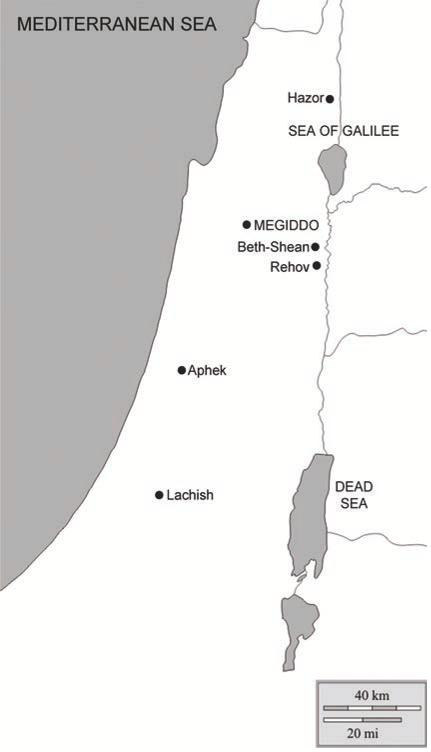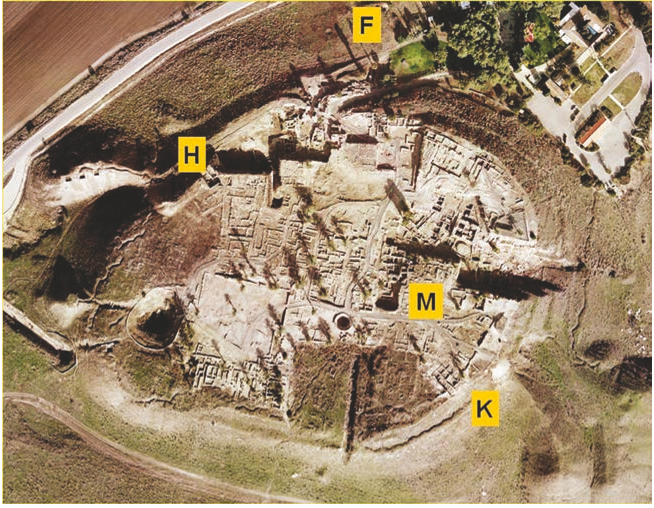
Radiocarbon, Vol 56, Nr 1, 2014, p 221–244 DOI: 10.2458/56.16899
© 2014 by the Arizona Board of Regents on behalf of the University of Arizona
ABSOLUTE CHRONOLOGY OF MEGIDDO, ISRAEL, IN THE LATE BRONZE AND
IRON AGES: HIGH-RESOLUTION RADIOCARBON DATING
Michael B Toffolo
1,2,3
• Eran Arie
4
• Mario A S Martin
2
• Elisabetta Boaretto
1
• Israel Finkelstein
2,5
ABSTRACT. Megiddo (Israel) is a key site for the study of the stratigraphy, chronology, and history of the Bronze and
Iron ages in the Levant. The article presents a Bayesian chronological model for seven ceramic typology phases and 10
stratigraphic horizons at this site, covering the Late Bronze and much of the Iron Age. The model is based on 78 samples,
which provided 190 determinations —the most thorough set of radiocarbon determinations known so far in a single site in the
Levant. This set of data provides a reliable skeleton for the discussion of cultural processes and historical events in the region
and beyond, including the periods of the Egyptian Empire in Canaan and the Northern Kingdom of Israel.
INTRODUCTION
The relative chronology of the Levant in the Late Bronze and Iron ages is well studied. It has been
established by investigating typological differences in large pottery assemblages. Thus, scholars
can now accurately identify ve Late Bronze Age horizons (hereafter LB IA, IB, IIA, IIB, and
III; e.g. Panitz-Cohen 2006; Mullins 2007; Gadot 2009; Martin 2013; Arie 2013b) and six Iron
Age horizons (early and late Iron I, early and late IIA, IIB, and IIC—e.g. Zimhoni 2004; Herzog
and Singer-Avitz 2004, 2006; Arie 2006, 2013c) for this timespan, which covers approximately a
millennium. Yet, the absolute chronology of these horizons is debated, for instance, regarding the
beginning of the LB (see below), the LB I-II, the details of the LB III/Iron I transition,
6
and the Iron
I/II transition (e.g. Sharon et al. 2007; Mazar and Bronk Ramsey 2008; Finkelstein and Piasetzky
2010b). This is so because of the lack of well-dated nds, such as monuments and royal-name items
of Egyptian monarchs, in Levantine strata representing much of this sequence. And this, in turn,
hinders a proper reconstruction of the history of the Levant, for example, regarding the exact time of
the transformation of the region into an Egyptian New Kingdom province; the process of collapse of
the Egypto-Canaanite system at the end of the Late Bronze Age; and the rise of territorial kingdoms
such as Israel, Judah, and Damascus in the Iron Age.
Rigorous programs of dating the Iron Age phases have been underway in the last decade (e.g.
Boaretto et al. 2005; Sharon et al. 2007; Mazar and Bronk Ramsey 2008; Finkelstein and Piasetzky
2010a). Dates for Late Bronze strata have also been published (e.g. Carmi and Ussishkin 2004 for
Lachish; Mazar et al. 2005 for Rehov; Mazar 2007, 2009 for Beth-Shean; Boaretto et al. 2009 for
Aphek; Figure 1), but no comprehensive project for dating the entire Late Bronze sequence has thus
far been attempted.
Models that use dates for samples that were retrieved in a large number of sites, such as those
suggested for the Iron Age, have clear advantages, e.g. in their geographical scope, but face meth-
odological problems such as different sample-retrieval procedures and inclusion of sites with less-
1. Weizmann Institute-Max Planck Center for Integrative Archaeology, D-REAMS Radiocarbon Laboratory, Weizmann
Institute of Science, Rehovot, Israel.
2. Sonia and Marco Nadler Institute of Archaeology, Tel Aviv University, Tel Aviv, Israel.
3. Corresponding author. Email: michael.toffolo@weizmann.ac.il.
4. Samuel and Saidye Bronfman Archaeology Wing, The Israel Museum, Jerusalem, Israel.
5. Michael B Toffolo is a PhD candidate at Tel Aviv University, working on the theme of Levantine and Aegean chronology
in the Iron Age under the supervision of Israel Finkelstein and Elisabetta Boaretto; Mario A S Martin and Eran Arie are senior
staff members of the Megiddo Expedition, the supervisors of Areas K and H and experts of Late Bronze and Iron Age pottery;
Elisabetta Boaretto is the Director of the D-REAMS Radiocarbon Laboratory at the Weizmann Institute of Science and track
leader of the European Research Council project (below); Israel Finkelstein is the Director of the Megiddo Expedition and
P.I. of the European Research Council under the European Community’s Seventh Framework Programme (FP7/2007–2013)/
ERC project, grant agreement n°229418.
6. With LB III we refer to the period of the 20th Dynasty in Egypt. Others, e.g. Mazar, label this phase Iron IA.

222
M B Toffolo et al.
than-ideal ceramic control and different methods of excavation. Thus, voices have been raised re-
garding the need to establish a full absolute sequence in a single site (Levy et al. 2010:844). This
should ideally be done with the involvement of the radiocarbon laboratory experts in the eld. The
advantage of such an endeavor is in the unied methods of decisions regarding context, retrieval of
samples, and recording.
This article presents a full
14
C Bayesian model of the Late Bronze and Iron Age phases at Tel Megid-
do, Israel (Figure 1). This is the most complete dating program applied to a single multilayered
site and the rst full
14
C-based model for the Late Bronze Age. Megiddo has long been considered
a key site for the archaeology of the Levant (e.g. Davies 1986; Kempinski 1989), including the
chronologies of both the Late Bronze and the Iron Age. The presented model covers 10 stratigraphic
phases (Table 1) and is based on 190 determinations from 78 samples, retrieved from four different
excavation areas. This is the most comprehensive dating project thus far undertaken in any single
site in the Levant. It sheds light on a large number of archaeological and historical issues, especially
those related to the Egyptian rule in Canaan in the Late Bronze Age and the struggle between the
territorial kingdoms of the Iron Age as recorded in written sources, including the Hebrew Bible.
Figure 1 Map of southern Levant showing the Iron Age
sites mentioned in the article.

223
Absolute Chronology of Megiddo in the Late Bronze & Early Iron
Table 1 The Megiddo levels discussed in this article, by area.
Level Relative chronology Nature of stratum
Ref. to stratigraphy
and architecture Ref. to pottery
Area K
K-4 Late Iron I Large, rectangular
courtyard house,
massive destruc-
tion
Gadot et al. 2006a Arie 2006
K-5 Early Iron I Fragmentary remains
of a domestic
building
Gadot et al. 2006a Arie 2006
K-6 LB III Courtyard building
with olive-oil
installation
Arie and Nativ 2013 Arie 2013a
K-7 LB IIB Domestic buildings,
slight changes in
the plan of Level
K-8
Martin et al. 2013 Martin 2013
K-8 LB IIB Domestic buildings Martin et al. 2013 Martin 2013
K-9 LB IIA Domestic building;
evidence for long-
term occupation
Not published yet Not published yet
K-10 Late MB–LB I Domestic architecture
and intramural
burials
Not published yet Not published yet
Area H
H-5 Late Iron IIA Plastered piazza Arie 2013a Arie 2013c
H-7 Early Iron IIA Domestic occupation;
thick accumulation
of oors
Arie 2013a Arie 2013c
H-9 Late Iron I Patrician house Arie 2013a Arie 2013b
H-10 Early Iron I Pillared building Not published yet Not published yet
H-11 Early Iron I Fragments of building
surrounded by
courtyards; jewelry
hoard
Not published yet Not published yet
H-12 LB III and early
Iron I
Large courtyards with
very thick accumu-
lation of oors
Not published yet Not published yet
H-13 LB IIB Elaborate building Not published yet Not published yet
Area M
M-4 Late Iron I Public building
(shrine?) and relat-
ed remains
Franklin 2013;
Pechuro 2013;
Finkelstein 2013
Arie 2013b
M-6 LB III End phase of a large
public building
(the Nordburg)
Franklin 2013;
Pechuro 2013;
Finkelstein 2013
Arie 2013b
Area F
F-10 LB I Domestic buildings Franklin 2006 Gadot et al. 2006b

224
M B Toffolo et al.
Megiddo
Megiddo is the ultimate site for a full chronological model for the Late Bronze and Iron ages. This
is so for the following reasons:
• The site was inhabited continuously, with no major occupational gaps (differing from Hazor,
for instance, which was deserted in the LB III and in part of the Iron I, and Lachish, which was
abandoned in the Iron I).
• The Late Bronze-Iron Age layers were uncovered in two sectional trenches located on the edge of
the tell in different sectors of the site: Area K, characterized by domestic habitations, and Area H,
close to the gate and the palace (Figure 2). The two trenches are large enough (15 × 25 and 10 ×
20 m, respectively) to enable establishing a solid stratigraphic sequence (Figures 3–4). Additional
data come from Area M, located in the center of the site, and Area F on its lower terrace. In addition
to the construction of a full chronological model, this opens the way for intrasite observations.
• The site is being carefully excavated. The ratio of experienced archaeologists to student volun-
teers in each area is 1-to-4 or -5. The pace of excavation is slow: in Area K, for instance, the oors
of Level K-10 (end of the Middle Bronze and beginning of the Late Bronze), located ~5 m below
the current surface of the mound, were reached after ~55 weeks of excavations in nine seasons.
• The Late Bronze-Iron Age sequence at Megiddo features an unparalleled series of four destruc-
tion layers (Figure 5). Because they feature large assemblages of nds, they can serve as reliable
pegs that enable secure control over phases of ceramic typology (relative chronology) and pro-
vide an especially large number of samples for
14
C dating.
• Because of the importance of the site, its ceramic assemblages include Egyptian and Aegean
forms, which can help establishing chronological links with neighboring lands.
Figure 2 Aerial view of Tel Megiddo, indicating the location of the excavation areas that pro vided
the samples for
14
C dating.

225
Absolute Chronology of Megiddo in the Late Bronze & Early Iron
• Last but not least, Megiddo is mentioned in a plethora of written sources (it is the only site in
the Levant that is mentioned in all great archives/writings of the ancient Near East–Egyptian,
Assyrian, the Hebrew Bible, and a single Hittite document), in connection to major events in the
Late Bronze-Iron Age sequence. They facilitate links between the archaeological and historical
records.
No other site in the Levant features this set of factors.
Tables 1–2 summarize the nature of the levels discussed in this paper, their relative chronology and
stratigraphic relationship.
Figure 3 General view of Area K pointing to some of the levels mentioned in the text
Figure 4 General view of Area H showing the location of some of the archaeological levels
mentioned in the text.





